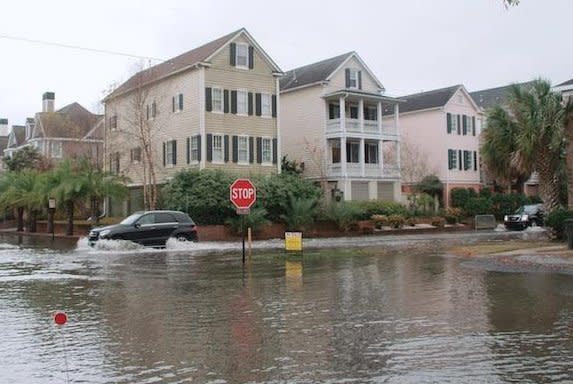U.S. tidal flooding breaks records as El Niño forecast to bring even more in 2024

Aug. 22 (UPI) -- Tidal flooding along the East and West coasts of the United States reached record highs in eight locations over the past year as the National Oceanic and Atmospheric Administration predicts El Niño will push record flooding into 2024.
NOAA released its 2023 Annual High Tide Flooding Outlook on Tuesday and predicted that next year the United States will experience three times the number of "nuisance flood" or "sunny flood" days than what occurred in 2000.
High tide flooding events are unrelated to severe weather and can occur on sunny days whenever tides reach between 1 and 2 feet above the daily average high tide. While these events -- which are also referred to as "nuisance flooding" -- are not caused by severe weather, NOAA warned storm surges are also expected to worsen due to climate change.
Tuesday's report shows high tide flooding events from May 2022 to April 2023 at 98 NOAA tide gauges along both U.S. coasts. Eight of the locations tied or broke records during that time period.
In Florida, Trident Pier saw 16 days of high tide flooding and Vaca Key had two days. In the Caribbean, Margueyes Island, Puerto Rico, also broke records with two days of tidal flooding.

In addition to flooding caused by high tides, Florida residents are raising concerns about urban flooding during this year's Atlantic hurricane season amid El Niño. El Niño occurs when Pacific Ocean water temperatures increase near the equator, which is known to affect global weather.
Over the past year, five other U.S. locations tied previous tidal flooding records. In Virginia, Kiptopeke had 11 high tide flood days to tie its record in 1997. In Georgia, Fort Pulaski also tied with 13 flood days. In Florida, Fernandina Beach saw nine days and Naples had three days. The only location on the West coast that saw high tide flooding in the past year was in Washington, where Port Townsend tied its 1982 record with 13 flood days.
"Communities across the country are seeing more and more high tide flooding, with damaging effects to transportation systems and infrastructure -- particularly in our most underserved communities," Jainey Bavishi, NOAA deputy administrator, said in a statement Tuesday.
"With sea level rise and a strong El Niño, NOAA's forecasts are a critical resource for our nation's communities as they plan and take proactive action to build their climate resilience," Bavishi added.
According to NOAA, high tide flooding will become more common in the future as sea levels rise due to climate change.
Looking ahead, NOAA predicts that from May 2023 to April 2024 the United States will experience four to nine high tide flood days. That is an increase over last year's prediction of three to seven days, as El Niño is expected to impact high tides along the East and West coasts.
Compared to the year 2000, the Mid-Atlantic is expected to see close to a 350% increase next year with nine to 15 high tide flooding days. The western Gulf can also expect a 350% increase with seven to 14 days.
The Pacific Northwest will see a 150% increase in high tide flooding next year -- over the year 2000 -- with four to 11 flood days predicted, while the Pacific Southwest can expect a 100% increase with one to five days of flooding forecast.
As NOAA looks at how current data can forecast and help plan for the future, it predicts the United States will experience an average of 45 to 85 high tide flooding days every year by 2050.
"Armed with more precise and timely data, coastal communities can make informed decisions about flooding risks, and take action to mitigate impacts by closing roads, performing maintenance on storm drain systems and protecting vulnerable infrastructure."

